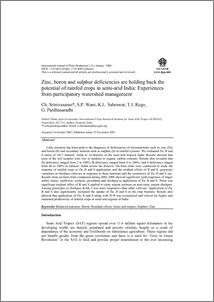Zinc, boron and sulphur deficiencies are holding back the potential of rainfed crops in semi-arid India: Experiences from participatory watershed management
Abstract
Little attention has been paid to the diagnosis of deficiencies of micronutrients such as zinc (Zn) and boron (B) and secondary nutrient such as sulphur (S) in rainfed systems. We evaluated Zn, B and S status of 1617 farmers’ fields in 14 districts of the semi-arid tropical India. Results showed that most of the soil samples were low to medium in organic carbon contents. Results also revealed that Zn deficiency ranged from 2 to 100%, B deficiency ranged form 0 to 100%, and S deficiency ranged from 40 to 100% in farmers’ fields across the districts. On-farm trials were conducted to study the response of rainfed crops to Zn, B and S application, and the residual effects of B and S, genotypic variations in chickpea cultivars in response to these nutrients and the economics of Zn, B and S use. Results from on-farm trials conducted during 2002-2006 showed significant yield responses of finger millet, maize, sunflower, soybean, groundnut and chickpea to application of Zn, B and S. There was significant residual effect of B and S applied to rainy season soybean on post-rainy season chickpea. Among genotypes of chickpea, KAK-2 was more responsive than other cultivars. Application of Zn, B and S also significantly increased the uptake of Zn, B and S in the crop biomass. Results also showed that application of Zn, B and S along with N+P was economical and critical for higher and sustained productivity of rainfed crops in semi-arid regions of India

